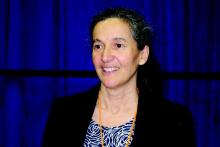SAN ANTONIO – Adding ovarian suppression to 5 years of tamoxifen in women with hormone receptor–positive early breast cancer who remain premenopausal following chemotherapy provides a markedly greater reduction in breast cancer recurrence, compared with standard adjuvant therapy with tamoxifen alone – and combining ovarian suppression with an aromatase inhibitor instead of tamoxifen further improves outcomes, Dr. Prudence Francis reported at the San Antonio Breast Cancer Symposium.
This was a key finding of SOFT (Suppression of Ovarian Function Trial), a randomized comparison of adjuvant tamoxifen or exemestane plus ovarian suppression versus tamoxifen alone in 3,047 patients in 25 countries, making this the largest randomized trial ever conducted in premenopausal women with hormone receptor–positive breast cancer.
The other key finding in SOFT was that not all premenopausal patients obtained benefit from ovarian suppression. Those who didn’t receive chemotherapy based upon a decision made with their physician had excellent outcomes with 5 years of tamoxifen alone, with a 95.8% disease-free survival at 5 years. In these patients, who were typically closer to the age of natural menopause onset and had cancers with a more favorable pathology than women who underwent chemotherapy, adding ovarian suppression offered no further advantage over tamoxifen alone, added Dr. Francis, who is head of breast medical oncology at the Peter MacCallum Cancer Center, Melbourne, Australia.
She called the SOFT results practice changing, and other experts agreed.
“For me, when I go back to my practice on Monday and I see a woman under age 35 with a hormone-sensitive breast cancer, I will now know what to advise that woman,” Dr. Francis said. “The strength of my recommendation for exemestane plus ovarian function suppression following chemotherapy will be greater in that woman; I’ll feel like maybe I should be recommending it rather than discussing it, because the advantage is so great. And when I see a premenopausal woman who is 48 and who’s got a small, screen-detected, nonaggressive breast cancer, I will feel very comfortable that she can do quite well with tamoxifen alone.”
The SOFT trial was unique in that it mandated that only women with documented recovery of ovarian function within 8 months of completing chemotherapy were eligible for enrollment.
At a median follow-up of 5.6 years, the 5-year disease-free survival rate was 84.7% in patients randomized to tamoxifen alone and not significantly different at 86.6% in those assigned to tamoxifen combined with ovarian function suppression. But the study design included two distinct populations – 53% who received chemotherapy and 47% who didn’t – and their outcomes were distinctly different.
The group who had undergone chemotherapy tended to have a higher baseline recurrence risk. They were younger – average age 40 – and typically had larger, higher-grade tumors and were more likely to be node positive. Their 5-year rate of freedom from breast cancer recurrence was 78% with tamoxifen alone, 82.5% with tamoxifen and ovarian suppression, and 85.7% with exemestane combined with ovarian suppression. That translates to a 22% decrease in the relative risk of recurrence in women on tamoxifen plus ovarian suppression. The absolute 7.7% difference in freedom from recurrent breast cancer at 5 years between women on exemestane plus ovarian suppression, compared with tamoxifen alone equated to a 35% relative risk reduction.
The advantage of ovarian suppression was most dramatic in the 350 study participants under age 35. Their 5-year rate of freedom from recurrent breast cancer was 67.7% with tamoxifen alone, 78.9% with tamoxifen combined with ovarian suppression, and 83.4% with exemestane and ovarian suppression, for a hefty absolute difference of 15.7%, compared with tamoxifen only.
Prior studies suggested that women diagnosed with hormone receptor–positive breast cancer before age 35 are at particularly high risk of disease recurrence. This was borne out in SOFT. One in three women under age 35 assigned to tamoxifen alone had further breast cancer within 5 years, compared with just one in six on exemestane plus ovarian suppression, Dr. Francis reported.
Systematic assessment of quality of life and treatment toxicities featured prominently in the SOFT trial. Add-on ovarian suppression was associated with increased rates of menopausal symptoms, insomnia, hypertension, diabetes, osteoporosis, and depression. The endocrine toxicities became less pronounced after 2 years. Patient reports of sexual dysfunction were more prominent and longer lasting in the exemestane group. Fifteen percent of women stopped ovarian suppression by 2 years, and 22% by 3 years.
Discussant Dr. Hope S. Rugo noted that while only 4.7% of breast cancers are diagnosed in women under age 40, that still adds up to roughly 11,000 new cases per year in the United States alone.


